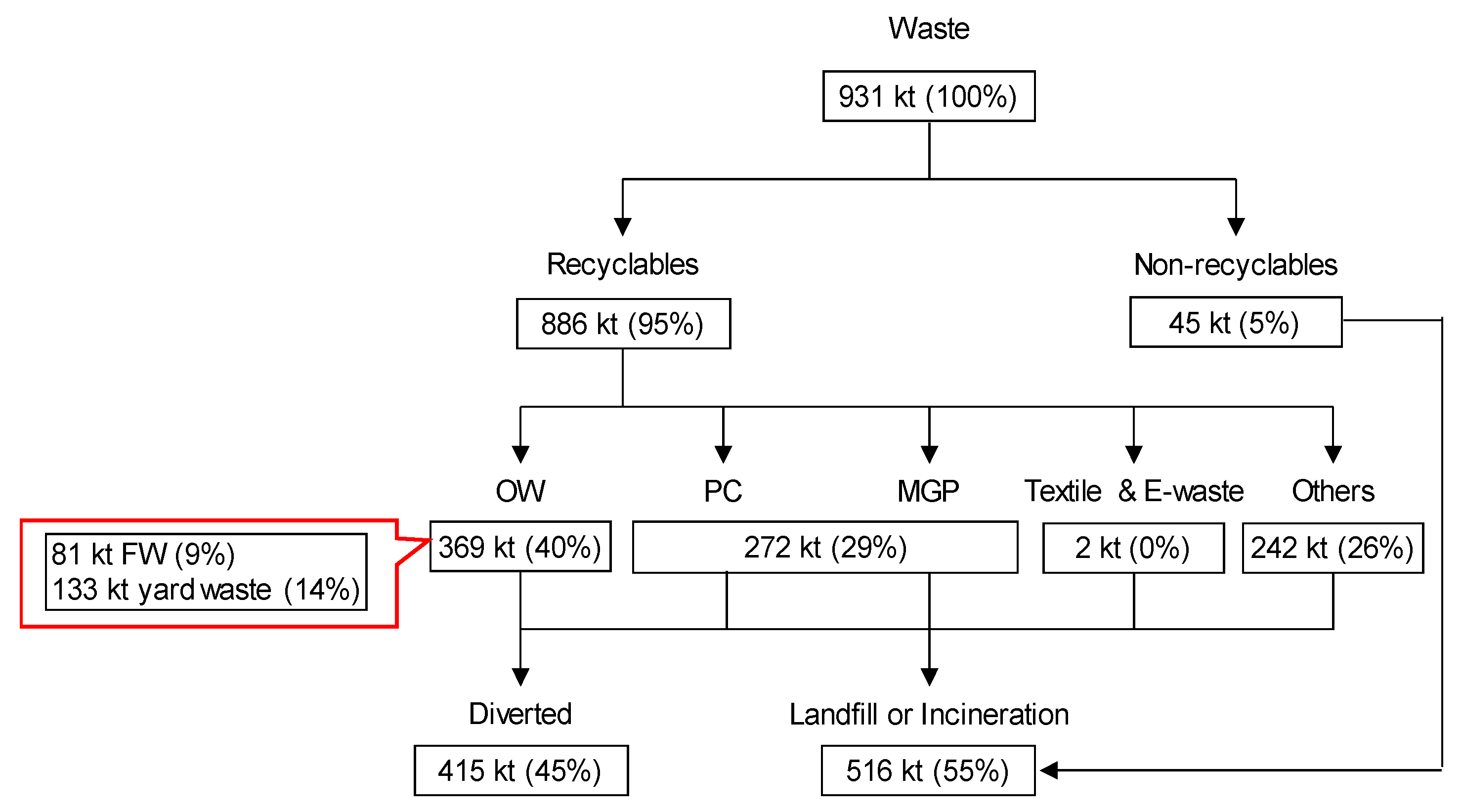Improving Municipal Solid Waste Management Strategies of Montréal (Canada) Using Life Cycle Assessment and Optimization of Technology Options
Abstract
1. Introduction
2. Current Status of Waste Management in Montreal
2.1. Data Collection and Analysis
2.2. Trend in Waste Generation
2.3. Waste Flow
3. Methodology
3.1. LCA Methodology
3.1.1. Goals, Functional Unit and System Boundary
3.1.2. Life Cycle Inventory
3.1.3. Life Cycle Impact Assessment
3.2. Waste Management Scenarios
3.3. Optimization
3.3.1. Objective Functions
3.3.2. Constraints
3.3.3. Method
4. Results and Discussion
4.1. LCA Results
4.2. Optimization Results
4.3. Discussion
- (1)
- As mentioned above, the biggest challenge is complete separation and sorting of different types of the waste. Creating sorting units for the whole amount of waste is an expensive solution. Therefore, another solution is encouraging people to be more interested in source separation of waste.
- (2)
- Hydro Québec is the only supplier of electricity in the province of Québec. Unfortunately, there is no specific policy about buying self-generated electricity from private suppliers. Therefore, it affects the interest from external investors to help to construct expensive units like AD and incineration.
- (3)
- The other existing challenge is the public awareness. People should become aware of the hazards of landfilling the municipal waste and realize what an important role they play in different waste management scenarios.
- (4)
- Another challenge is the location of new AD and incineration units and whether there should be one central unit or several distributed units across the city. Although a study by [36] concluded the advantages of a fully decentralized AD systems, the authors believe that more detailed LCA studies are needed to find the solution for this problem.
- (5)
- The severe weather condition in Montréal during its long winters is another challenge for utilizing organic waste management facilities like AD and composting units. Further thermal energy would be required to keep the system in an optimum temperature condition. Especially in case of AD and composting, cold weather might slow down the degradation process. Putting the AD in a greenhouse has been suggested and is recommended. Study by [42] showed that an AD could 49% less heat energy by being housed in a greenhouse.
5. Conclusions
Author Contributions
Funding
Conflicts of Interest
References
- Mayer, F.; Bhandari, R.; Gath, S. Critical review on life cycle assessment of conventional and innovative waste-to-energy technologies. Sci. Total Environ. 2019, 672, 708–721. [Google Scholar] [CrossRef] [PubMed]
- Malmir, T.; Tojo, Y. Municipal solid waste management in Tehran: Changes during the last 5 years. Waste Manag. Res. 2016, 34, 449–456. [Google Scholar] [CrossRef] [PubMed]
- Sindhu, R.; Gnansounou, E.; Rebello, S.; Binod, P.; Varjani, S.; Thakur, I.S.; Nair, R.B.; Pandey, A. Conversion of food and kitchen waste to value-added products. J. Environ. Manag. 2019, 241, 619–630. [Google Scholar] [CrossRef] [PubMed]
- United States Environmental Protection Agency. Advancing Sustainable Materials Management: 2014 Fact Sheet; United States Environmental Protection Agency, Office of Land and Emergency Management: Washington, DC, USA, 2016.
- United States Environmental Protection Agency. Advancing Sustainable Materials Management: 2015 Fact Sheet; United States Environmental Protection Agency, Office of Land and Emergency Management: Washington, DC, USA, 2018.
- Evangelisti, S.; Lettieri, P.; Borello, D.; Clift, R. Life cycle assessment of energy from waste via anaerobic digestion: A UK case study. Waste Manag. 2014, 34, 226–237. [Google Scholar] [CrossRef]
- European Environment Agency. Diversion of Waste from Landfill; European Environment Agency: Copenhagen, Denmark, 2019.
- Levaggi, L.; Levaggi, R.; Marchiori, C.; Trecroci, C. Waste-to-Energy in the EU: The Effects of Plant Ownership, Waste Mobility, and Decentralization on Environmental Outcomes and Welfare. Sustainability 2020, 12, 5743. [Google Scholar] [CrossRef]
- McDougall, F.R.; White, P.R.; Franke, M.; Hindle, P. Integrated Solid Waste Management: A Life Cycle Inventory; John Wiley & Sons: Hoboken, NJ, USA, 2001. [Google Scholar]
- Lundie, S.; Peters, G.M. Life cycle assessment of food waste management options. J. Clean. Prod. 2005, 13, 275–286. [Google Scholar] [CrossRef]
- De Feo, G.; Ferrara, C.; Iuliano, C.; Grosso, A. LCA of the Collection, Transportation, Treatment and Disposal of Source Separated Municipal Waste: A Southern Italy Case Study. Sustainability 2016, 8, 1084. [Google Scholar] [CrossRef]
- Lyng, K.-A.; Stensgård, A.E.; Hanssen, O.J.; Modahl, I.S. Relation between greenhouse gas emissions and economic profit for different configurations of biogas value chains: A case study on different levels of sector integration. J. Clean. Prod. 2018, 182, 737–745. [Google Scholar] [CrossRef]
- Nayal, F.S.; Mammadov, A.; Ciliz, N. Environmental assessment of energy generation from agricultural and farm waste through anaerobic digestion. J. Environ. Manag. 2016, 184, 389–399. [Google Scholar] [CrossRef]
- Grigatti, M.; Barbanti, L.; Hassan, M.U.; Ciavatta, C. Fertilizing potential and CO2 emissions following the utilization of fresh and composted food-waste anaerobic digestates. Sci. Total Environ. 2020, 698, 134198. [Google Scholar] [CrossRef]
- Quek, A.; Balasubramanian, R. Life Cycle Assessment of Energy and Energy Carriers from Waste Matter—A Review. J. Clean. Prod. 2014, 79, 18–31. [Google Scholar] [CrossRef]
- Gouvernement du Québec. The 2030 Energy Policy; Gouvernement du Québec: Montreal, QC, Canada, 2016.
- Mohsenizadeh, M.; Tural, M.K.; Kentel, E. Municipal solid waste management with cost minimization and emission control objectives: A case study of Ankara. Sustain. Cities Soc. 2020, 52, 101807. [Google Scholar] [CrossRef]
- Richter, A.; Bruce, N.; Ng, K.T.; Chowdhury, A.; Vu, H.L. Comparison between Canadian and Nova Scotian waste management and diversion models—A Canadian case study. Sustain. Cities Soc. 2017, 30, 139–149. [Google Scholar] [CrossRef]
- Ville de Montréal. Portrait 2016 des Matières Résiduelles de L’agglomération de Montreal; Ville de Montréal: Montreal, QC, Canada, 2017. [Google Scholar]
- Québec, Government of Québec, Institut de la statistique. 2015. Available online: www.stat.gouv.qc.ca/statistiques/profils/region_06/region_06_00_an.htm (accessed on 23 October 2019).
- Communauté Métropolitaine de Montréal. Draft amendment, To the 2015–2020 residual materials management plan for metropolitan Montréal; Communauté Métropolitaine de Montréal: Montreal, QC, Canada, 2019. [Google Scholar]
- Henault-Ethier, L.; Martin, J.P.; Housset, J. A dynamic model for organic waste management in Quebec (D-MOWIQ) as a tool to review environmental, societal and economic perspectives of a waste management policy. Waste Manag 2017, 66, 196–209. [Google Scholar] [CrossRef]
- Ville de Montréal. Bilan 2017 des Matières Résiduelles de L’agglomération de Montréal; Ville de Montréal: Montreal, QC, Canada, 2018. [Google Scholar]
- Nielsen, T.D.; Holmberg, K.; Stripple, J. Need a bag? A review of public policies on plastic carrier bags—Where, how and to what effect? Waste Manag. 2019, 87, 428–440. [Google Scholar] [CrossRef]
- Malmir, S.; Montero, B.; Rico, M.; Barral, L.; Bouza, R. Morphology, thermal and barrier properties of biodegradable films of poly (3-hydroxybutyrate-co-3-hydroxyvalerate) containing cellulose nanocrystals. Compos. Part A Appl. Sci. Manuf. 2017, 93, 41–48. [Google Scholar] [CrossRef]
- Malmir, S.; Montero, B.; Rico, M.; Barral, L.; Bouza, R.; Farrag, Y. PHBV/CNC bionanocomposites processed by extrusion: Structural characterization and properties. Polym. Compos. 2019, 40, E275–E284. [Google Scholar] [CrossRef]
- Guerin, J.E.; Paré, M.C.; Lavoie, S.; Bourgeois, N. The importance of characterizing residual household waste at the local level: A case study of Saguenay, Quebec (Canada). Waste Manag. 2018, 77, 341–349. [Google Scholar] [CrossRef]
- EPIC/CSR (Environment and Plastics Industry Council/Corporations Supporting Recycling). Integrated Solid Waste Management Tools: User Guidance Document; EPIC/CSR (Environment and Plastics Industry Council/Corporations Supporting Recycling): Carrey, NC, USA, 2000. [Google Scholar]
- Haight, M. Technical Report: Integrated Solid Waste Management Model; University of Waterloo: Waterloo, ON, Canada, 2004. [Google Scholar]
- Pourreza Movahed, Z.; Kabiri, M.; Ranjbar, S.; Joda, F. Multi-objective optimization of life cycle assessment of integrated waste management based on genetic algorithms: A case study of Tehran. J. Clean. Prod. 2020, 247, 119153. [Google Scholar] [CrossRef]
- Éco Entreprises Québec. Consultation Tarif 2019—Sommaire; Éco Entreprises Québec: Montreal, QC, Canada, 2019. [Google Scholar]
- Colvero, D.A.; Ramalho, J.; Gomes, A.P.D.; de Matos, M.A.A.; da Cruz Tarelho, L.A. Economic analysis of a shared municipal solid waste management facility in a metropolitan region. Waste Manag. 2020, 102, 823–837. [Google Scholar] [CrossRef]
- Deb, K. Multi-objective Optimization Using Evolutionary Algorithms; John Wiley & Sons: Hoboken, NJ, USA, 2001; Volume 16. [Google Scholar]
- Deb, K.; Pratap, A.; Agarwal, S.; Meyarivan, T.A.M.T. A Fast and Elitist Multiobjective Genetic Algorithm: NSGA-II. IEEE Trans. Evol. Comput. 2002, 6, 182–197. [Google Scholar] [CrossRef]
- Wang, Y.; Shen, Y.; Zhang, X.; Cui, G.; Sun, J. An Improved Non-dominated Sorting Genetic Algorithm-II (INSGA-II) applied to the design of DNA codewords. Math. Comput. Simul. 2018, 151, 131–139. [Google Scholar] [CrossRef]
- Thiriet, P.; Bioteau, T.; Tremier, A. Optimization method to construct micro-anaerobic digesters networks for decentralized biowaste treatment in urban and peri-urban areas. J. Clean. Prod. 2020, 243, 118478. [Google Scholar] [CrossRef]
- Christensen, T.H.; Damgaard, A.; Levis, J.; Zhao, Y.; Björklund, A.; Arena, U.; Barlaz, M.A.; Starostina, V.; Boldrin, A.; Astrup, T.F.; et al. Application of LCA modelling in integrated waste management. Waste Manag. 2020, 118, 313–322. [Google Scholar] [CrossRef]
- Habib, K.; Schmidt, J.H.; Christensen, P. A historical perspective of Global Warming Potential from Municipal Solid Waste Management. Waste Manag. 2013, 33, 1926–1933. [Google Scholar] [CrossRef] [PubMed]
- Bartocci, P.; Zampilli, M.; Liberti, F.; Pistolesi, V.; Massoli, S.; Bidini, G.; Fantozzi, F. LCA analysis of food waste co-digestion. Sci. Total Environ. 2020, 709, 136187. [Google Scholar] [CrossRef]
- Safdar, N.; Khalid, R.; Ahmed, W.; Imran, M. Reverse logistics network design of e-waste management under the triple bottom line approach. J. Clean. Prod. 2020, 272, 122662. [Google Scholar] [CrossRef]
- Sooriyaarachchi, T.M.; Tsai, I.T.; El Khatib, S.; Farid, A.M.; Mezher, T. Job creation potentials and skill requirements in, PV, CSP, wind, water-to-energy and energy efficiency value chains. Renew. Sustain. Energy Rev. 2015, 52, 653–668. [Google Scholar] [CrossRef]
- Walker, M.; Theaker, H.; Yaman, R.; Poggio, D.; Nimmo, W.; Bywater, A.; Blanch, G.; Pourkashanian, M. Assessment of micro-scale anaerobic digestion for management of urban organic waste: A case study in London, UK. Waste Manag. 2017, 61, 258–268. [Google Scholar] [CrossRef]
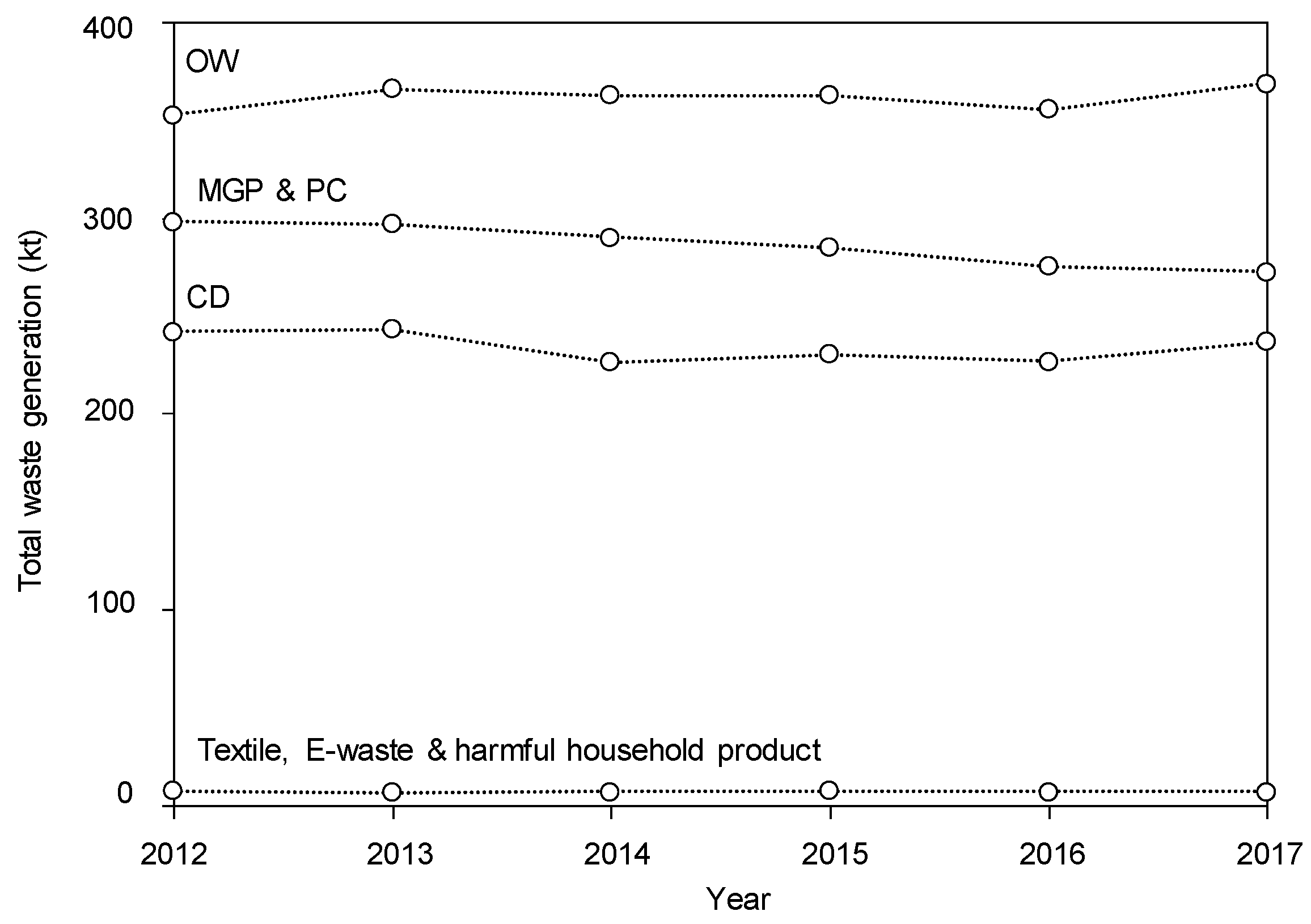
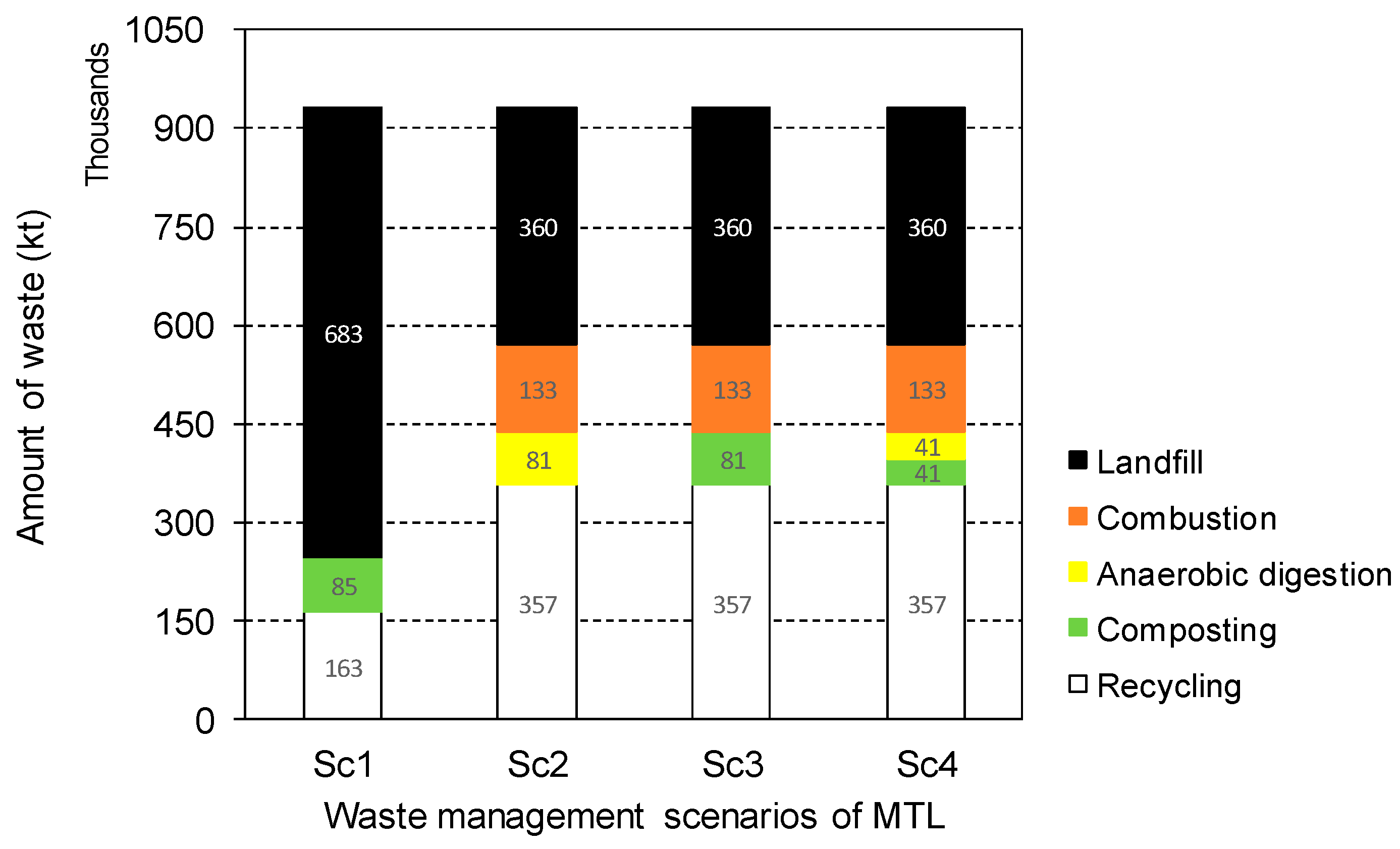
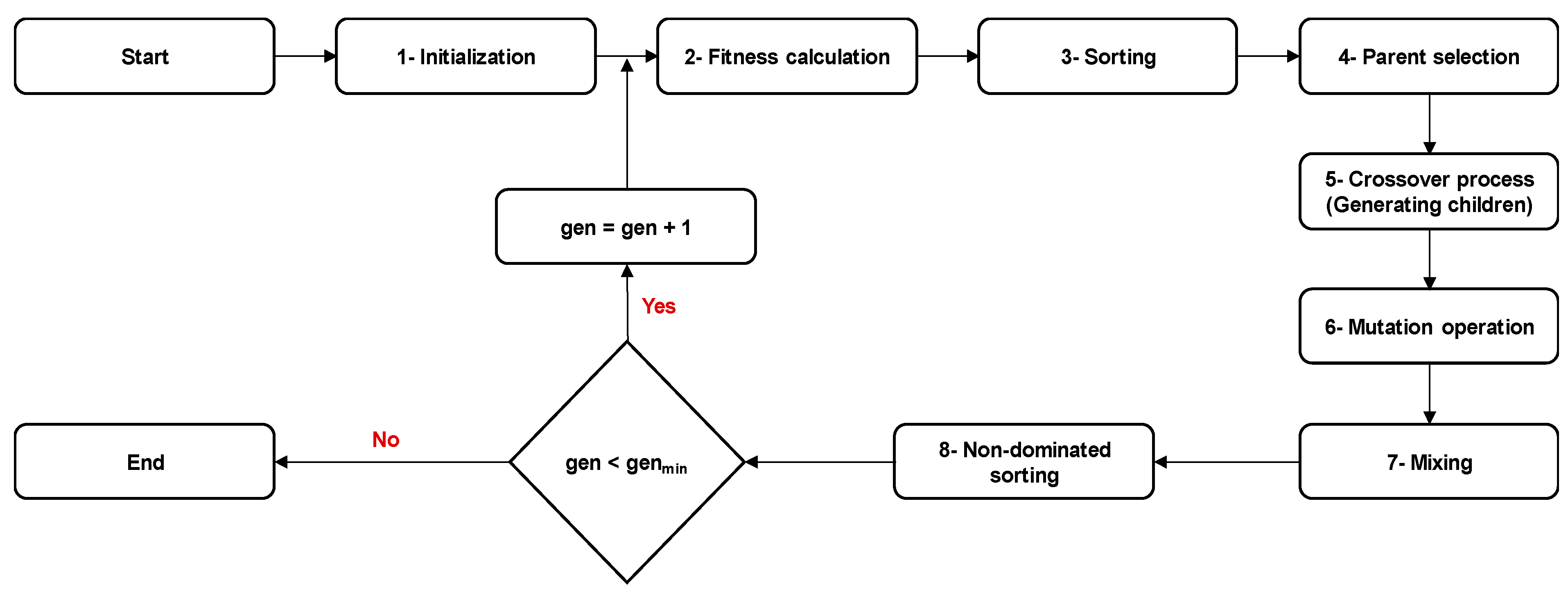
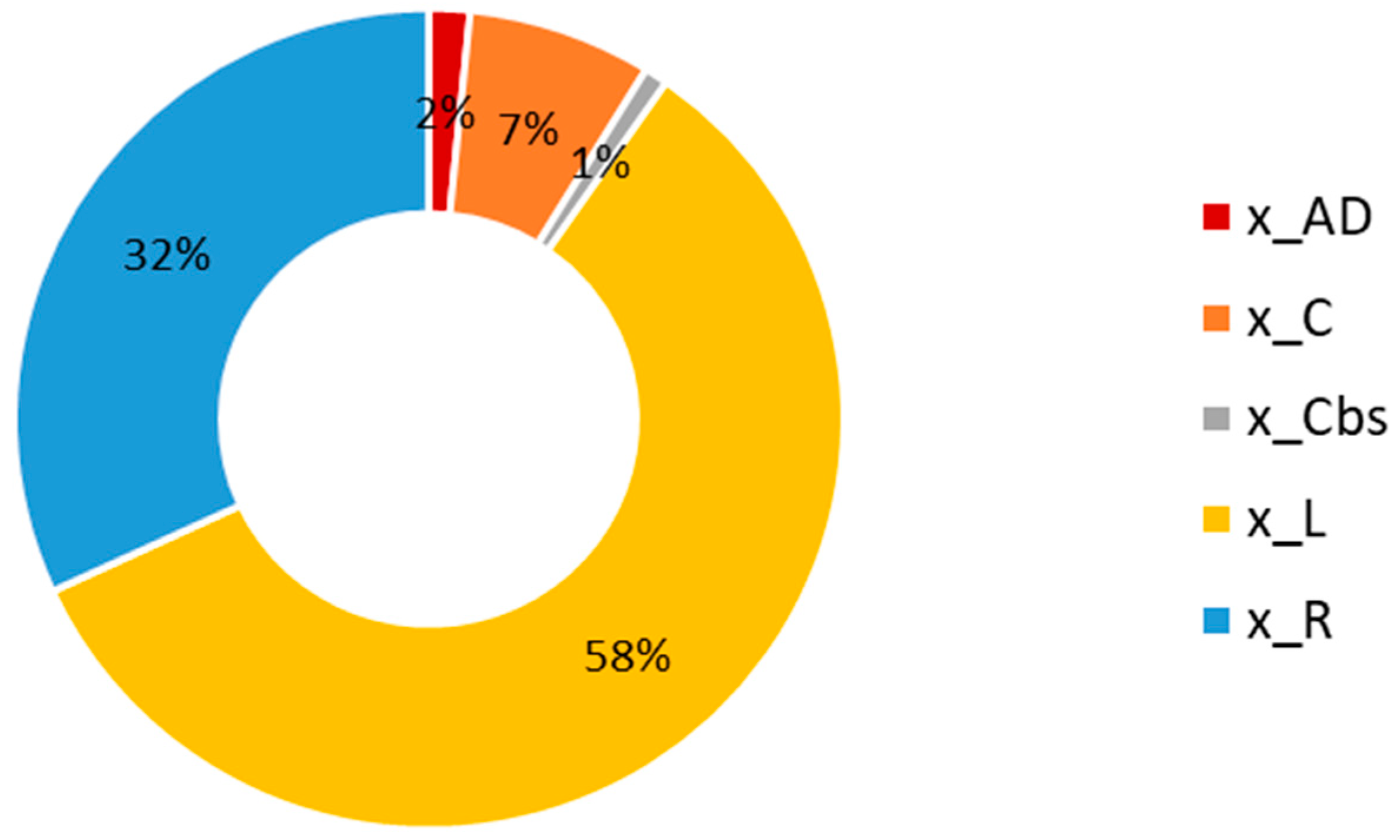
| Indicator Parameter | Indicator of | Unit |
|---|---|---|
| Energy | ||
| Total energy consumed | Resource depletion | GJ |
| Emissions to air | ||
| Greenhouse gases | Climate change | t |
| Carbon dioxide (CO2) | ||
| Methane (CH4) | ||
| Acid Gases | Acidification, health risk | t |
| Nitrogen oxides (NOx) | ||
| Sulphur dioxide (SO2) | ||
| Hydrogen chloride (HCl) | ||
| Smog precursors | Urban smog formation, health risk | t |
| Volatile organic compounds (VOC) | ||
| Nitrogen oxides (NOx) | ||
| Particulate matter (<10 microns) (PM-10) | ||
| Heavy metals | Health risk | kg |
| Lead (pb) | ||
| Cadmium (Cd) | ||
| Mercury (Hg) | ||
| Trace organics | Health risk | g |
| Dioxins & Furans (TEQ) | ||
| Emissions to water | ||
| Heavy metals | Health risk, environmental degradation | kg |
| Lead (pb) | ||
| Cadmium (Cd) | ||
| Mercury (Hg) | ||
| Trace organics | Health risk, environmental degradation | mg |
| Dioxins & Furans (TEQ) | ||
| Biochemical Oxygen Demand (BOD) | Water quality, environmental degradation | kg |
| Emissions to land | ||
| Residual solid waste | Land use disruption | t |
| Technology | Capital Cost (CAD/t) | Operating Costs (CAD/t) | Reference |
|---|---|---|---|
| Recycling | 190 x | 190 x | [31] |
| Composting | 4000 x0.7 | 7000 x−0.6 | [32] |
| AD | 35000 x0.6 | 17000 x−0.6 | [32] |
| Incineration | 5000 x0.8 | 700 x−0.3 | [32] |
| Landfilling | 6000 x0.6 | 100 x−0.3 | [32] |
| Case | GHG Emissions (kt) | Acid Gases Emissions (kt) | Smog Emissions (kt) | Residuals (kt) | Energy (TJ) | ||||||
|---|---|---|---|---|---|---|---|---|---|---|---|
| CO2 | CH4 + NOX | CO2eq | NOX | SOX | HCl | NOX | PM | VOC | |||
| Sc1 | −76 | 6 | 69 | 0.07 | 0.02 | 0.001 | 0.07 | 0.22 | 0.05 | 695 | −6869 |
| Sc2 | 9 | 4 | 142 | 0.19 | 0.04 | 0.02 | 0.19 | 0.13 | 0.05 | 427 | −13,530 |
| Sc3 | 9 | 3 | 127 | 0.17 | 0.04 | 0.02 | 0.17 | 0.15 | 0.04 | 417 | −14,027 |
| Sc4 | 11 | 3 | 144 | 0.20 | 0.04 | 0.02 | 0.20 | 0.14 | 0.06 | 423 | −14,043 |
| Technology | Input | μ | σ | a | b | c | |
|---|---|---|---|---|---|---|---|
| Recycling | xR | Energy | 2.6 ×105 | 6.2 ×104 | −115 | −1.2 ×106 | −1.1 ×107 |
| CO2 | −10 | −1.1 ×105 | −9.4 ×105 | ||||
| Composting | xC | Energy | 1.3 ×104 | 1.4 ×104 | 23 | 1658 | 3.3 ×104 |
| CO2 | −0.03 | 160 | 8104 | ||||
| AD | xAD | Energy | 5.9 ×104 | 1.4 ×104 | 22 | −5 ×104 | −1.6 ×105 |
| CO2 | 6 | 712 | 1.8e4 | ||||
| Incineration | xCbs | Energy | 6.6 ×104 | 4.3 ×104 | −3.6 ×104 | −3 ×105 | −3.8 ×105 |
| CO2 | 284 | 7989 | 1.2 ×104 | ||||
| Landfilling | xL | Energy | 5.2 ×105 | 1 ×105 | −243 | 3025 | 3.1 ×104 |
| CO2 | −974 | 8597 | 9.6 ×104 |
| Design Number | xAD (t) | xC (t) | xCbs (t) | xL (t) | xR (t) | Ctotal (kt of CO2) | Costtotal (CAD) | Etotal (Tj) |
|---|---|---|---|---|---|---|---|---|
| 1 | 14,710 | 66,393 | 8580 | 54,0166 | 29,4955 | −879 | 12,3000607 | −11,809 |
| 2 | 14,525 | 66,393 | 7880 | 55,6522 | 29,4861 | −877 | 12,3203356 | −11,802 |
| 3 | 14,684 | 66,393 | 8271 | 54,2802 | 29,7906 | −884 | 12,3464210 | −11,866 |
Publisher’s Note: MDPI stays neutral with regard to jurisdictional claims in published maps and institutional affiliations. |
© 2020 by the authors. Licensee MDPI, Basel, Switzerland. This article is an open access article distributed under the terms and conditions of the Creative Commons Attribution (CC BY) license (http://creativecommons.org/licenses/by/4.0/).
Share and Cite
Malmir, T.; Ranjbar, S.; Eicker, U. Improving Municipal Solid Waste Management Strategies of Montréal (Canada) Using Life Cycle Assessment and Optimization of Technology Options. Energies 2020, 13, 5701. https://doi.org/10.3390/en13215701
Malmir T, Ranjbar S, Eicker U. Improving Municipal Solid Waste Management Strategies of Montréal (Canada) Using Life Cycle Assessment and Optimization of Technology Options. Energies. 2020; 13(21):5701. https://doi.org/10.3390/en13215701
Chicago/Turabian StyleMalmir, Tahereh, Saeed Ranjbar, and Ursula Eicker. 2020. "Improving Municipal Solid Waste Management Strategies of Montréal (Canada) Using Life Cycle Assessment and Optimization of Technology Options" Energies 13, no. 21: 5701. https://doi.org/10.3390/en13215701
APA StyleMalmir, T., Ranjbar, S., & Eicker, U. (2020). Improving Municipal Solid Waste Management Strategies of Montréal (Canada) Using Life Cycle Assessment and Optimization of Technology Options. Energies, 13(21), 5701. https://doi.org/10.3390/en13215701




